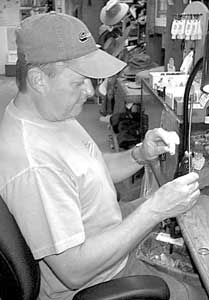
The Cherokee Indians were the first fly fishers in the mountains, fashioning hooks from chipped stone and deer bones and wrapping the shanks of their hooks with deer hair. They fished their flies wet, catching the abundant brook trout, which, until the late 1800s, were the only salmonids populating southern Appalachian streams.
Early settlers continued the fly-fishing tradition, adapting and modifying the Cherokee deer hair fly and creating patterns that worked best in the high-gradient mountain streams.
One of the best known traditional mountain fly patterns is the Yellow Hammer, or “yallerhammer,” as it’s called locally.
Roger Lowe, a master fly-tier from Waynesville, said the Yellow Hammer is a “very effective fly, one of the first flies to come to mind when you think about fishing North Carolina trout streams.”
Many early fly fishers believed a fly with a little “yaller” in it would attract trout.
Early versions of the Yellow Hammer utilized the bright quills of the yellow-shafted flicker. The quills were wrapped around the shank of a hook, reverse-palmer style.
The stiff quills vibrated slightly when pulled through a current, creating an irresistible lure for trout. After the flicker became an endangered bird, fly tiers switched to dyed grouse and dove feathers to resemble the bright, yellow plumage of the flicker.
The late Fred Hall of Bryson City turned out thousands of Yellow Hammers for local and visiting fly fishers.
Hall and his wife, Alleen, produced a variety of flies for local and visiting trout fishers. He is credited with originating the Tellico nymph, the Adams Variant, and Thunder Head, as well as other patterns.
Over the years, numerous flies have been created or modified from popular patterns specifically for southern Appalachian trout streams, flies that have been time-tested by generations of mountain anglers.
These flies are featured in a new book by Roger Lowe, a fly-fishing guide and owner of Lowe Fly Shop in Waynesville.
“Roger Lowe’s Fly Pattern Guide to the Great Smoky Mountains” features 101 traditional fly patterns, many of which are found only in Western North Carolina.
Lowe said the got the idea for the book from customers wanting to know what a particular pattern looked like and how to tie it.
“They were especially interested in old patterns,” he said.
Lowe provides only the materials used in the flies, not instructions how to tie the flies. The photos are of such quality, though, that an experienced fly-tier would have little difficulty tying the flies.
A fly-tier for 35 years, Lowe said some of the people who originated the flies featured in his book were blood relatives (“kin”) or friends.
“I wanted something that would continue the fly-tying tradition long after I give it up,” he said.
Lowe said he learned his craft from such master fly-tiers as Frank Coffey, Bennie Craig, Charles Messer, and Ralph Mills, all from Haywood County.
“They set the standards on how the old patterns should be tied,” he said, “and I’m trying to continue the tradition.”
Many of their flies, along with some of Lowe’s creations, are included in the guide. These flies include the Charlie Whopper, created by Charles Messer; Coffey’s Stone Creeper, created by Frank Coffey; and the Hazel Creek and Lowe’s Stone, created by Lowe.
A few well-known flies such as the male and female Adams, Royal Coachman and Pheasant tail also are included.
Lowe said he has about 300 patterns at his fly shop, the majority of them tied by him, his wife, Diane, and son, Brent.
Lowe’s flies also are featured in the N.C. Wildlife Resources Commission’s “Southern Appalachian Fly Patterns“ poster.
The guide is available at area fly shops and outfitters.
It also can be obtained directly from Lowe Fly Shop, 15 Woodland Drive, Waynesville, N.C. 28786.
Cost is $25.24, which includes shipping and postage.




Be the first to comment